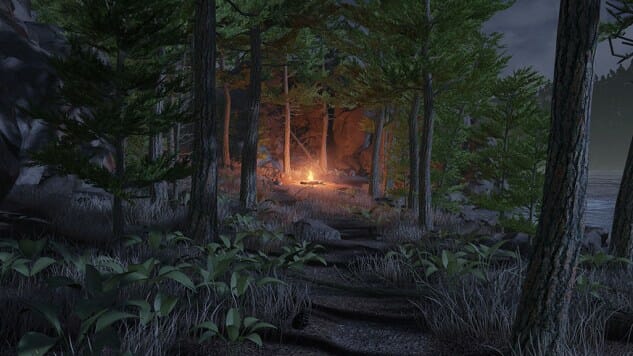Talking Obduction and Myst With Rand Miller
Photo of Rand Miller courtesy of Cyan Inc. / Cyan Worlds Inc. Games Features Obduction
It’s taken a while for Rand Miller, the lead mind behind ‘90s superhit Myst, to come around again. It’s not that he disappeared, per se, but once the blazing fire of popularity that Myst stoked calmed down, he sort of moved into the background, quietly working on other things. After a successful Kickstarter campaign, however, Miller and his company, Cyan Worlds, are finally back with Obduction—a game very true to the form and spirit of his original classic.
If you weren’t there, you might have no idea just how big a deal Myst was. It essentially created a whole new subgenre of adventure game—contemplative, lonely puzzle and exploration games with beautiful pre-rendered scenery became the rage for a long time afterward. Myst also helped usher in the CD-ROM era and Miller is remarkably low key about the whole thing now.
“Well, I think in my younger days, I’d have said, ‘Yea, we had something to do with that!’,” Miller speculated. “In my older days, I think, ‘Boy, you were lucky, Rand.’ I feel very fortunate.”
Miller attributes a lot of this success to mere timing and knowing what the constraints of the then brand new CD-ROM format would be. They worked out a game that would fit the new media in a unique way. It was a gamble that paid off, eventually becoming one of the greatest selling games of all time.
I spent a fair amount of time talking to Miller about Obduction, his thoughts on the industry, and his past work. As it turns out, the road from Myst to Obduction was a winding one. “Myst Online is essentially what [his time between Myst and now] is best summarized as. We did an amazing project that for the sake of my fragile ego and sanity, I choose to believe was ahead of its time,” he told me. “I’m really, really proud of what we pulled off. We signed up 40,000 beta testers and then the publisher pulled the plug. They got cold feet on the whole online market. So, we picked ourselves up and did what we had to stay alive.”
When Ubisoft unceremoniously pulled the plug on Myst Online one week before launch (they also did something similar to The Matrix Online), it hit Miller and his company hard. They had invested a lot of their time and money in the project. “We were truly building online as if it were a regular content delivery system. Where you would come back to it every day or week or month and there would be substantial content changes,” He explained. “So, we had set up a studio just to build content a year in advance—lots of content that would be rolled into [the game]—and that just shut down as well.
“We had to scramble and figure out what to do with that content and we shrunk in size, and the mobile market kind of kept us alive because we’re ‘scrappy’.”
Myst Online did make it out as a largely single-player boxed copy called Uru and Ubisoft ended up using a lot of that extra content for expansion packs and even the work-for-hire Myst 5. “The publisher kind of had us by the scruff of the neck, so we did (Myst 5) and it was work for hire,” Miller furthered. “It had some aspects that I actually liked, but I would have liked it better if the content had been part of Myst Online and a part of that larger story.”
Still, the closing of Miller’s dream Myst game—an ever expanding and changing online Myst universe—was a deep blow, both financially and morale-wise. So, he went back to the start, doing something that he’d done a lot of in the ‘90s—retooling Myst and his other earlier work for newer platforms.
“The mobile market came at a good time for us. We’re a small developer in the middle of nowhere,” he said. “But it just so happened that about the time we were really hurting, the mobile market was picking up and could support our earlier works.
“So, we converted our earlier children’s software like The Manhole and we did Myst for the mobile market and even our real-time 3D version of Myst, and then Riven.” This move managed to keep the company afloat and let them ramp up enough to consider the Kickstarter for Obduction.
Obduction isn’t a sequel, but it bears a strong resemblance to Miller’s earlier game series. I wondered why he keeps coming back to the genre he pioneered. “I still feel like that the strength of the interactive is not telling a story, but making the player feel like they’re the storyteller,” he explained. “It just feels like it’s your story to tell now and I think there’s something powerful with that.”
One of the reasons that I personally liked the writing part of Myst was that it had a kind of dark aspect to the storytelling. Obduction has a distinctly similar vibe. In Myst, the player was abducted by a mysterious force and swept off to an alien island, where the only encounters were recorded ghosts of people who were there before. There are a lot of threads in the way Miller starts his stories off that seem consistent.
“In Obduction it was consistent for a reason,” he agreed. “The weird thing is that with Myst we were able to plop you into a situation where you didn’t have a clue what was going on. The somewhat ironic aspect of the sequels was that that could not be true, because they were sequels and you already knew what was going on.
“So, I think we were trying to recapture some of that and there’s something about lonely places where people aren’t that do have a little bit of a horror feel. We were surprised after Myst, that people would say ‘Oh, it freaked me out. I’d walk down a hallway and get chills’. And I don’t think it was anything we did. I think it was just the loneliness that somehow you think something is going to appear or be behind you.”
That sense of isolation, as it turns out, is both a thematic and technical choice. ”Whenever you put characters in a game, the more you put in the more they just kind of glaringly reveal the weakness of characters in games,” he explained. “You get the uncanny valley, the inability to truly interact with them. You can’t really talk with them yet. So, it feels like controlling and reducing that is good from a technical point of view and from a virtual realism point of view.
“But beyond that, there’s something mesmerizing and also reassuring about being in a place by yourself,” he continued. “Maybe it’s weird, but I think it’s reassuring. You know nobody’s going to come and mess up stuff that you’ve done. It’s a little bit eerie and disconcerting, but at least it feels like your kingdom.”
Obduction takes these themes—you don’t know what the story is or why you’re here—and transforms them with far greater visual and audio fidelity. The game is stunningly gorgeous with a powerful soundtrack and intriguing story. Gone are the days of slow click to move, picture frame gameplay, although funnily enough, Miller actually went through the effort of including that classic one-mouse-button control option.
“It was a lot of work to offer that option. We had to put nodes in every single spot and connect them all,” he explained. “The nice part was that in a weird circular kind of aspect, VR makes use of this kind of gameplay as well. But I think one thing we didn’t want to lose is that Myst was popular with a crowd of people who would’ve been intimidated with game controllers or keyboard controls. Myst was just a one-button mouse and a screen and we wanted to get a little of that back.”
He laughingly calls this “Mom Mode,” because he could sit his mom in front of the game and she be able to make progress. “If I tried to describe to her WASD and a mouse or a controller,” he joked, “she’d be like ‘No.’ She’s not going to even try that. So, it is nice to jump back a little to make it more accessible for a larger group and especially the group that maybe originally tried Myst”
Now post-release, Cyan Worlds is still working on making everything just right for Obduction. They’re adding VR support and patching things up when problems arise, but Miller’s plans for the future are a bit more nebulous in nature.
“We’re not really good at business here. That’s the best way to put it,” he commented. “If we were, we’d already have another team that’s already going down a road on a design and procured all the funding for that. We put everything we’ve got into (Obduction) and that’s how it’s been for the almost last three years.
“But we have a couple paths that seem obvious. We definitely like VR and the feeling it gives. Of course, everyone we talk to says they want to walk around in Myst VR. That seems like a no-brainer at some point, but I don’t know when we’ll do that or how it will fit into things. Motivation is a big thing here and we have a lot of talented people that we want to keep challenged, and (Myst VR) may or may not be the next thing.”
Provided Obduction reaches the level of success it deserves, we also hope to see more from this new world. In the meantime, Myst-style games in the truest sense of the word—before they devolved into a million odd “hidden object” type games—have been rare in recent years. Obduction brings the beloved genre back in a big and beautiful way.
Jason D’Aprile has been covering games and entertainment for the last three decades across a variety of platforms, many of which are now extinct. In addition to covering gaming (both obscure and otherwise), he also writes a bit of the odd fiction and tries hard to avoid social media.
